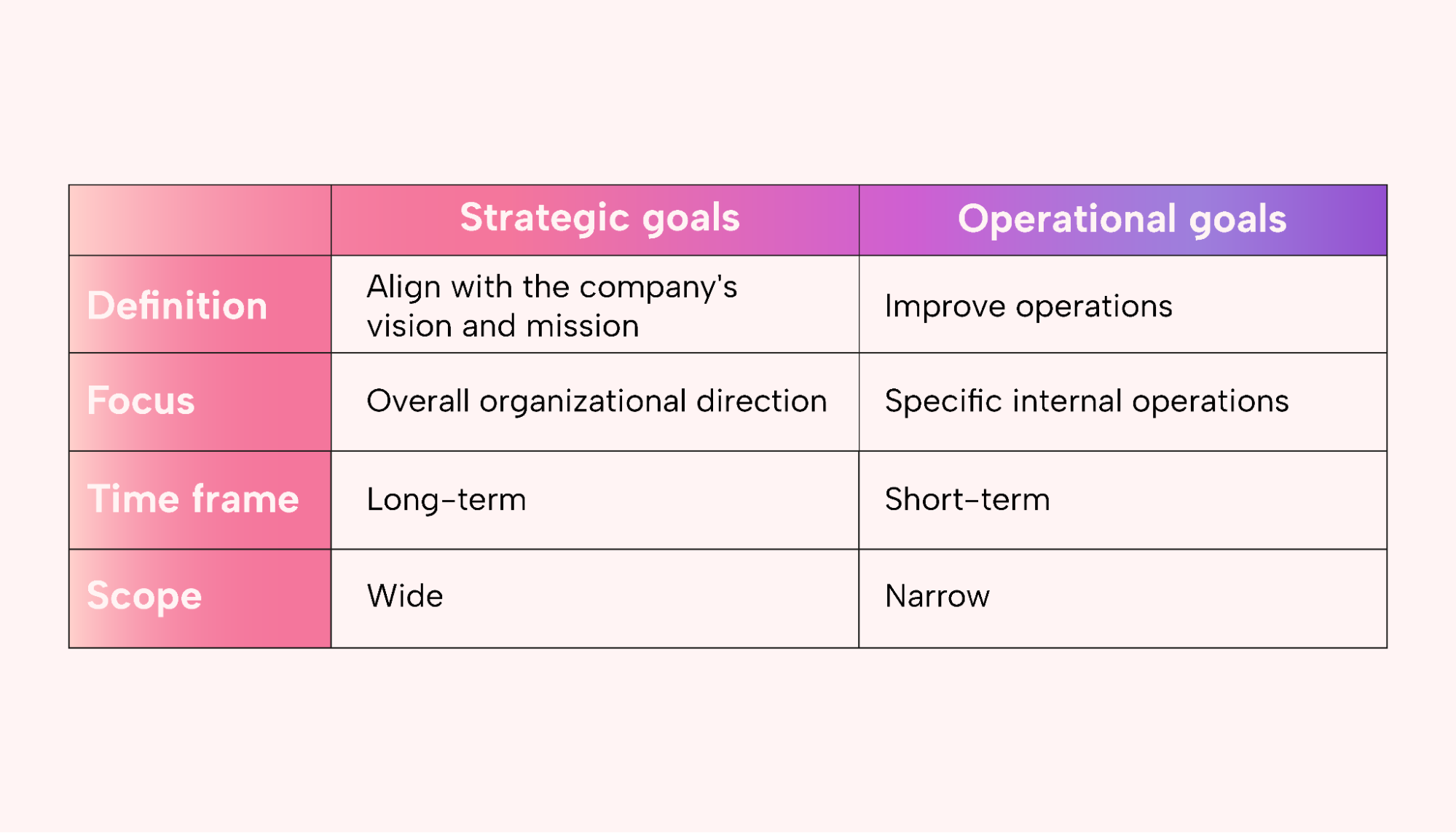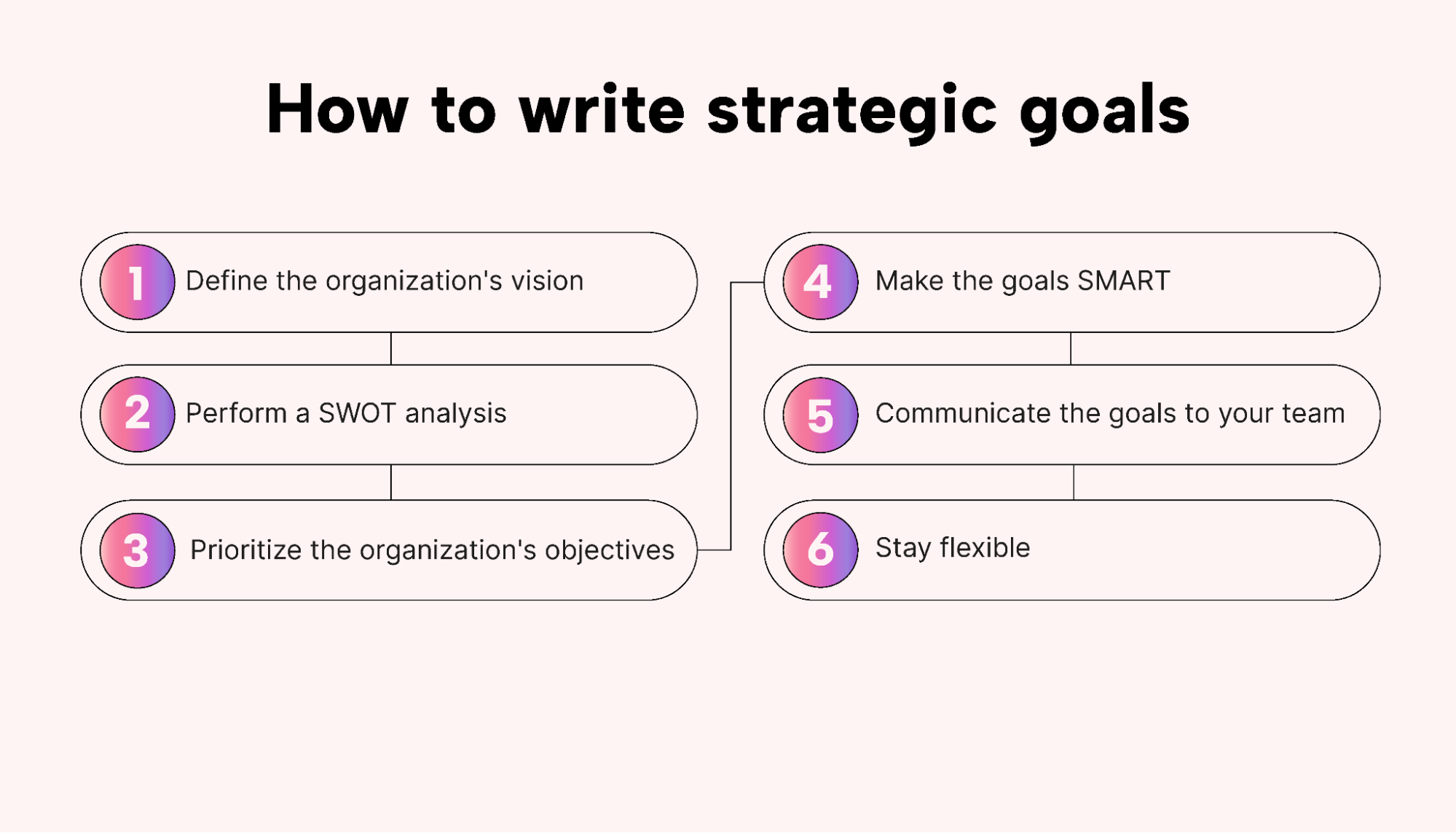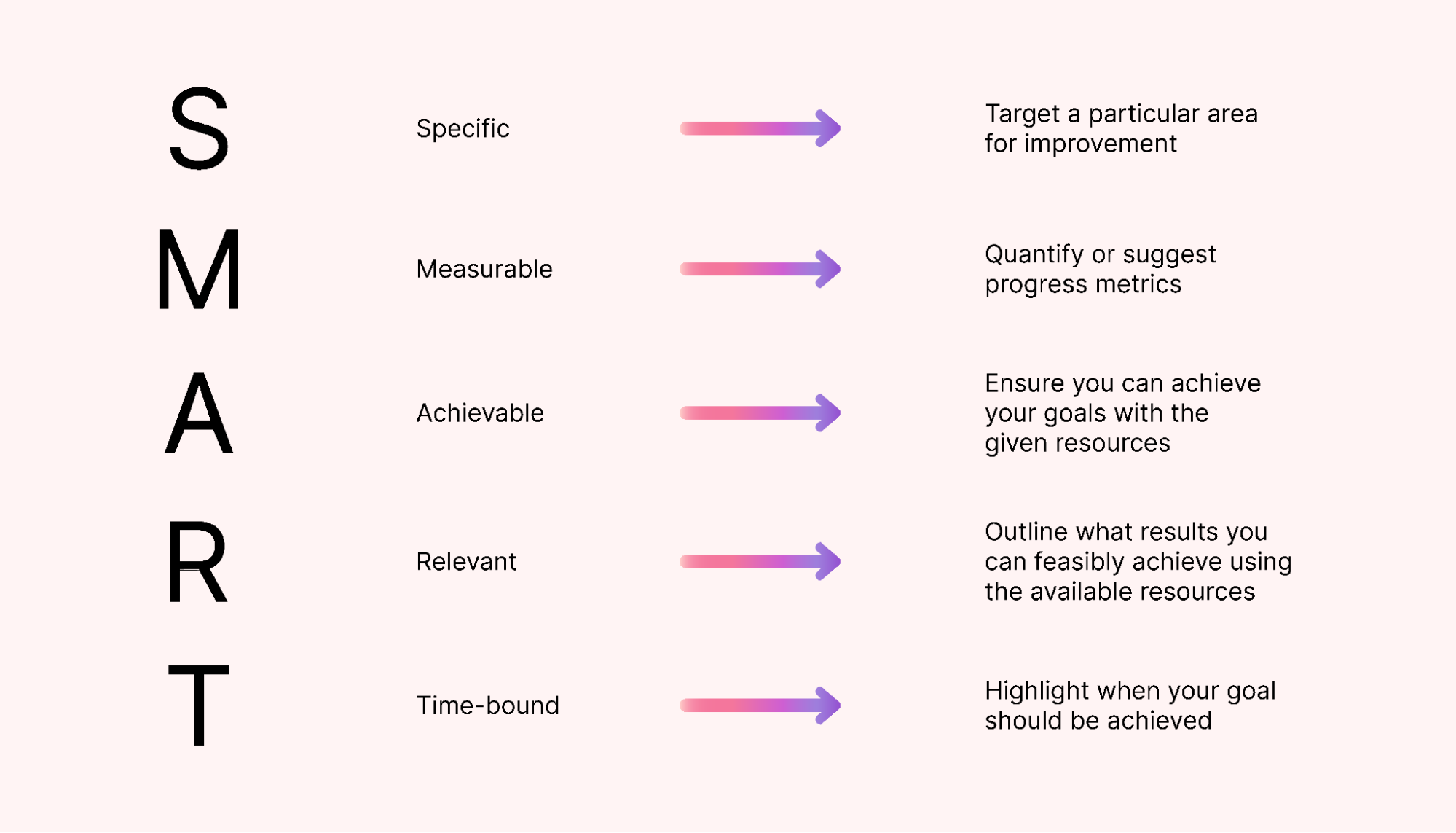At the heart of every prosperous organization, from multinational corporations to grassroots nonprofits, are well-defined goals.
But it’s not just about setting goals; it’s about setting the right goals.
Strategic goals serve as the backbone of any successful endeavor, guiding organizations and individuals with a clear vision.
But what do strategic goals look like? And how do you create them?
We’ll break down what strategic goals are and how to develop clear, purposeful ones that can help take your team to the next level.
What are strategic goals?
Strategic goals are broad, primary outcomes or objectives that organizations aim to achieve as they pursue their mission and long-term vision. They provide direction and purpose, guiding the organization’s efforts and resources over a specific time frame — usually several years.
Strategic goals are crucial for guiding organizational strategy.
Characteristics of strategic goals
Strategic goals are typically:
 |
- Broad in scope: Unlike tactical or operational goals, which often focus on specific tasks or short-term outcomes, strategic goals address high-level and long-term outcomes.
- Future-oriented: Strategic goals focus on desired future states or outcomes, pushing the organization forward.
- Motivating: Strategic goals inspire and engage members of the organization. They provide a sense of purpose and direction.
- Measurable: Though they are broad, strategic goals are quantifiable in some way so that progress toward achieving them can be tracked.
- Realistic yet challenging: Strategic goals are achievable, given the organization’s resources and constraints, but they are also demanding enough to drive performance.
- Aligned with the organization’s mission and vision: Strategic goals directly support the organization’s mission (its core purpose) and vision (its desired future state).
- Limited in number: Organizations shouldn’t have too many strategic goals at once. A handful is enough.
- Long-term: Strategic goals typically span multiple years, though the exact time frame can vary depending on the organization and the context of the goal.
Strategic goals vs. other types of goals
Now that we’ve delved into what strategic goals are, you might be wondering how they differ from other goal types.
 |
Operational goals
Operational goals are specific targets that relate to the day-to-day functions of an organization. They focus on the internal processes and procedures that need to be improved or enhanced for the organization to meet its strategic goals.
Operational goals are usually short-term goals — often set on a yearly basis.
“Reduce production downtime by 10% this year” is an example of an operational goal for a manufacturing company.
Tactical goals
Tactical goals bridge the gap between strategic and operational goals. They are focused on how to achieve strategic objectives by outlining specific steps or actions to be taken within a shorter time frame — usually one to three years.
An example of a tactical goal would be “Launch three new product lines within the next 24 months to capture a greater market share.”
SMART goals
SMART stands for specific, measurable, achievable, relevant, and time-bound. SMART goals provide a framework for setting objectives that are clear, realistic, and trackable.
For instance, instead of simply saying, “Increase sales,” a SMART goal would specify, “Increase sales by 15% over the next six months by expanding our online marketing efforts.”
Stretch goals
Stretch goals are ambitious targets that go beyond what seems achievable based on the organization’s current circumstances or past performance. They are designed to push the organization out of its comfort zone to achieve exceptional results. While stretch goals are challenging, they’re not completely unrealistic.
“Increase annual revenue by 60% instead of the organization’s typical 20% growth” would be an example of a stretch goal.
The importance of strategic goals
Let’s now delve into how strategic goals can shape an organization’s future.
Provide direction and purpose
Strategic goals provide the organization with a clear direction. They define what the company aims to achieve in the long term, ensuring that everyone is working toward a common objective.
Guide decision-making
Strategic goals act as a guiding light for decision-making at all organizational levels. When faced with choices, managers and leaders can refer to the business’s strategic goals to ensure alignment with long-term objectives.
Improve resource allocation
Clear strategic goals help organizations more effectively allocate their resources (time, money, manpower). They help leaders prioritize initiatives that directly contribute to the organization’s pursuit of desired outcomes.
Enhance performance measurement
Strategic goals allow organizations to measure their performance over time. Setting them allows organizations to track their progress, identify areas for improvement, and ensure accountability.
Boost motivation and engagement
Clear and compelling goals inspire and motivate employees. And when employees understand and believe in the organization’s objectives, they are more likely to be engaged and committed to their roles.
 |
Support stakeholder communication
Strategic goals communicate the organization’s ambition and future direction to external stakeholders, such as investors, partners, and customers. They provide a sense of stability and assurance that the organization is forward-thinking and has a plan in place.
Align team members
Strategic goals help ensure that different departments or teams within the organization are aligned. Everyone knows the bigger picture, which helps avoid conflicts and overlaps. This, in turn, fosters a sense of unity and collaboration.
How do you write a strategic goal?
Ready to write your own strategic goals? The steps below will provide a solid foundation for setting goals that guide your organization’s direction.
 |
1. Define the organization’s vision
Before diving into specific goals, it’s crucial to have a clear vision statement. A vision statement paints a picture of the organization’s future and clarifies the direction in which the company is heading. It answers the question, “Where do we want to be?”
A vision statement should be aspirational yet grounded in reality. Engage with different stakeholders, from employees to customers, to get diverse input when creating your vision.
As an example, Google’s vision statement is “To provide access to the world’s information in one click.”
2. Perform a SWOT analysis
A SWOT analysis is a structured approach to evaluating the internal and external factors that impact an organization. It involves examining strengths, weaknesses, opportunities, and threats. Understanding where the organization excels and where challenges lie can help you craft goals that leverage your strengths and address areas of improvement.
Conduct regular SWOT sessions — ideally involving team members from various departments to get a holistic view of the organization.
3. Prioritize the organization’s objectives
Not all objectives are created equal. Determine which goals will best help you realize the organization’s vision and prioritize them. Use tools like the Eisenhower Matrix to determine your goals’ urgency and importance.
For example, if an e-commerce company identifies international expansion and launching a mobile app as objectives, but budget and time are constraints, it might prioritize the app based on potential immediate revenue.
4. Make the goals SMART
SMART goals are designed to be clear and reachable.
 |
A goal like “increase sales” is vague. However, “increase sales by 15% in the next 12 months” is specific, measurable, achievable, relevant, and time-bound. This clarity increases the goal’s effectiveness and the likelihood of achieving it.
5. Communicate the goals to your team
Once you’ve set the strategic goals, it’s essential to verify that everyone in the organization understands them. This encourages alignment, fosters collaboration, and ensures everyone is pulling in the same direction.
Use a variety of communication channels — such as team meetings, emails, and internal platforms — to ensure wide reach and comprehension.
6. Stay flexible
A business environment is dynamic. As situations change, be ready to adjust your goals as needed, ensuring they always align with the broader vision and the current context.
Schedule regular meetings to assess the relevance and practicality of current goals. Then, make adjustments based on real-time data and feedback.
14 strategic goals examples
Here are 14 examples of strategic goals for different business contexts:
- Corporate growth: “Achieve $2 billion in annual revenue by the end of 2025.”
- Market penetration: “Increase our market share in Europe from 15% to 25% by 2024.”
- Innovation: “Launch three new innovative products that address emerging market needs by the end of 2023.”
- Customer satisfaction: “Achieve a Net Promoter Score (NPS) of 80 or above consistently over the next three years.”
- Operational efficiency: “Reduce operational costs by 10% while maintaining product quality by Q4 2023.”
- Employee development: “Ensure 90% of employees undergo at least two professional development training sessions annually.”
- Environmental sustainability: “Reduce our carbon footprint by 50% by 2030 and implement a zero-waste policy in all our locations.”
- Expansion: “Open 20 new retail stores across Asia and North America by 2024.”
- Brand recognition: “Become one of the top three most recognized brands in our industry by 2025.”
- Digital transformation: “Implement an integrated digital platform to enhance customer experience, aiming for a 20% increase in online sales by 2023.”
- Supply chain optimization: “Establish two new distribution centers to decrease delivery lead times by 30%.”
- Community engagement: “Partner with five local nonprofits to drive community upliftment projects by 2024.”
- Product diversification: “Expand our product line to include five new categories by 2025.”
- Stakeholder engagement: “Increase shareholder dividend payouts by 10% year-over-year for the next five years.”
Strategic goal best practices
Incorporating the following best practices when setting strategic goals can significantly increase an organization’s likelihood of success, fostering a culture of clarity, commitment, and achievement:
- Break them down: Create clear, actionable steps for each goal. Splitting larger goals into smaller objectives or tasks makes them more manageable and less daunting. This approach allows for a systematic progression toward the end goal.
- Be realistic: Goals should be ambitious, but they also need to be achievable. Setting unrealistic targets can demotivate teams when they continually fall short. It’s vital to strike a balance between aspiration and practicality.
- Celebrate milestones: Recognizing and celebrating interim achievements can boost morale and motivation. These moments serve as reminders of progress and inspire teams to keep pushing forward.
- Consider external factors: External influences, such as market conditions, technological advancements, or regulatory changes, can impact the feasibility and relevance of strategic goals. Regularly reassess and adjust your strategic goals in light of these external developments.
- Document everything: Detailed documentation helps teams track their progress, make the necessary adjustments, and ensure transparent communication within the organization.

- Ensure accountability: Assign responsibility for each goal to specific teams or individuals. When people know they are accountable, they’re more likely to take ownership, drive results, and ensure their goals’ completion.
Bring your strategic goals to life with Motion
Strategic goals offer companies a clear direction and purpose, ensuring that every step taken aligns with the bigger picture. However, crafting and tracking these goals can be challenging.
Motion simplifies the goal-setting process, providing tools to help break down, monitor, and accomplish organizations’ ambitions. Its intuitive interface allows teams to stay synchronized, celebrate milestones, and adjust to challenges.
Don’t just set goals; achieve them with precision and efficiency using Motion. Sign up for a free 7-day trial today.





